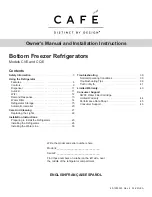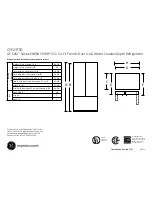
4
FEATURES
(Not all features are on all models)
About the shelves and bins.
Not all features are on all models.
Refrigerator bin
Snugger
Press tab and pull shelf
forward to remove
The slide-out spillproof shelf
allows you to reach items
stored behind others. The
special edges are designed
to help prevent spills from
dripping to lower shelves.
The snugger (on some models)
helps prevent tipping, spilling or
sliding of small items stored on
the door shelf. Place a finger on
either side of the snugger near
the rear and move it back and
forth to fit your needs.
The removable beverage rack (on some models) is designed
to hold a bottle on its side. It can be attached to any slide-out
shelf.
Proper clearances are needed for ease of installation, proper air circulation, and plumbing and electrical connections.
The clearances specific to your unit can be found on the rating plate (silver label on the top-right wall of the refrigerator
compartment).
1
2
CLEARANCES
NORMAL OPERATING SOUNDS
HUMMM...
WHOOSH...
The new high efficiency compressor may run faster and longer
than your old refrigerator and you may hear a high-pitched hum
or pulsating sound while it is operating.
You may hear a whooshing sound when the doors close. This is
due to pressure equalizing within the refrigerator.
After dispensing ice, a motor will close the ice chute to keep
warm room air from entering the ice bucket, maintaining ice at a
freezing temperature.
The hum of the motor closing the ice chute is normal, shortly
after dispensing ice.
You may hear the fans spinning at high speeds. This happens
when the refrigerator is first plugged in, when the doors are
opened frequently or when a large amount of food is added to
the refrigerator or freezer compartments. The fans are helping to
maintain the correct temperatures.
The fans change speeds in order to provide optimal cooling and
energy savings.
CLICKS, POPS,
CRACKS and SNAPS
You may hear cracking or popping sounds when the refrigerator
is first plugged in. This happens as the refrigerator cools to the
correct temperature.
Expansion and contraction of cooling coils during and after
defrost can cause a cracking or popping sound.
On models with an ice maker, after an ice making cycle, you may
hear the ice cubes dropping into the ice bucket.
On models with a dispenser, during water dispense, you may
hear the water lines move at initial dispense and after dispenser
button is released.
WATER SOUNDS
The flow of refrigerant through the cooling coils may make a
gurgling noise like boiling water.
Water dropping on the defrost heater can cause a sizzling,
popping or buzzing sound during the defrost cycle.
A water dripping noise may occur during the defrost cycle as ice
melts from the evaporator and flows into the drain pan.
Closing the door may cause a gurgling sound due to pressure
equalization.
Содержание Profile Series
Страница 7: ...7 Canada 1 800 661 1616 7...
Страница 8: ...8...
Страница 11: ...11 Notes GEAppliances com 11...





































